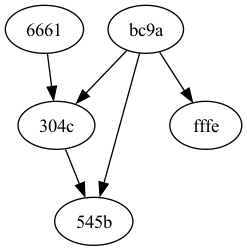hash-dag-go is a library for converting a vanilla Directed Acyclic Graphs (DAG) to a thing which I'm calling a hash DAG (which is not to be confused with the IPFS Merkle DAG).
The algorithm for computing the label of a node in the hash DAG is:
let H = some hashing function which produces a string
N = some node with data (a byte array) and a (possibly empty) array of parent nodes
SORT = lexicographical sorting function
CONCAT = concatenation
MAP = mapping function
in label = H(CONCAT(H(N.Data), SORT(MAP(N.Parents, H))))
 |
 |
 |
| input vanilla DAG | -> apply hashing function | -> output hash DAG |
package main
import (
"flag"
"github.com/laser/hash-dag-go"
"math/rand"
gvz "github.com/laser/random-dag-generator-go/render/graphviz"
"github.com/laser/hash-dag-go/vanilla"
)
var (
nodeQty = flag.Int("node-qty", 1+rand.Intn(20), "number of nodes in the DAG")
maxOutdegree = flag.Int("max-outdegree", 1+rand.Intn(4), "max number of edges directed out of a node")
edgeFactor = flag.Float64("edge-factor", 1.0-rand.Float64(), "probability of adding a new edge between nodes during the graph generation")
outputPath = flag.String("output-path", "/tmp/hash-dag.png", "path to which the generated DAG-PNG will be saved")
)
func main() {
flag.Parse()
input := vanilla.Graph{
Nodes: []vanilla.Node{
{Id: vanilla.NodeId("1"), Data: []byte("abc")},
{Id: vanilla.NodeId("2"), Data: []byte("def")},
{Id: vanilla.NodeId("3"), Data: []byte("ghi")},
},
Edges: []vanilla.Edge{
{SourceNodeId: vanilla.NodeId("1"), TargetNodeId: vanilla.NodeId("2")},
{SourceNodeId: vanilla.NodeId("1"), TargetNodeId: vanilla.NodeId("3")},
{SourceNodeId: vanilla.NodeId("3"), TargetNodeId: vanilla.NodeId("2")},
},
}
// builds a new hash DAG from the input DAG using a hash of the node data
// plus its parents hashes as the node id
mdag := hashdag.From(input)
converted := gvz.From(mdag)
gvz.RenderTo(converted, *outputPath)
}